Heterozygous STAT1 gain-of-function mutations underlie an unexpectedly broad clinical phenotype
- PMID: 27114460
- PMCID: PMC4920021
- DOI: 10.1182/blood-2015-11-679902
Heterozygous STAT1 gain-of-function mutations underlie an unexpectedly broad clinical phenotype
Abstract
Since their discovery in patients with autosomal dominant (AD) chronic mucocutaneous candidiasis (CMC) in 2011, heterozygous STAT1 gain-of-function (GOF) mutations have increasingly been identified worldwide. The clinical spectrum associated with them needed to be delineated. We enrolled 274 patients from 167 kindreds originating from 40 countries from 5 continents. Demographic data, clinical features, immunological parameters, treatment, and outcome were recorded. The median age of the 274 patients was 22 years (range, 1-71 years); 98% of them had CMC, with a median age at onset of 1 year (range, 0-24 years). Patients often displayed bacterial (74%) infections, mostly because of Staphylococcus aureus (36%), including the respiratory tract and the skin in 47% and 28% of patients, respectively, and viral (38%) infections, mostly because of Herpesviridae (83%) and affecting the skin in 32% of patients. Invasive fungal infections (10%), mostly caused by Candida spp. (29%), and mycobacterial disease (6%) caused by Mycobacterium tuberculosis, environmental mycobacteria, or Bacille Calmette-Guérin vaccines were less common. Many patients had autoimmune manifestations (37%), including hypothyroidism (22%), type 1 diabetes (4%), blood cytopenia (4%), and systemic lupus erythematosus (2%). Invasive infections (25%), cerebral aneurysms (6%), and cancers (6%) were the strongest predictors of poor outcome. CMC persisted in 39% of the 202 patients receiving prolonged antifungal treatment. Circulating interleukin-17A-producing T-cell count was low for most (82%) but not all of the patients tested. STAT1 GOF mutations underlie AD CMC, as well as an unexpectedly wide range of other clinical features, including not only a variety of infectious and autoimmune diseases, but also cerebral aneurysms and carcinomas that confer a poor prognosis.
Figures


Comment in
-
When the STATs are against you.Blood. 2016 Jun 23;127(25):3109-10. doi: 10.1182/blood-2016-05-715029. Blood. 2016. PMID: 27340249 No abstract available.
References
Publication types
MeSH terms
Substances
Grants and funding
LinkOut - more resources
Full Text Sources
Other Literature Sources
Medical
Research Materials
Miscellaneous

